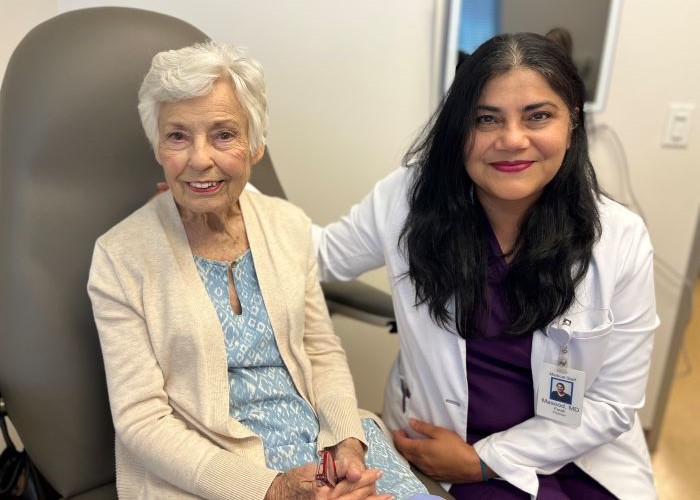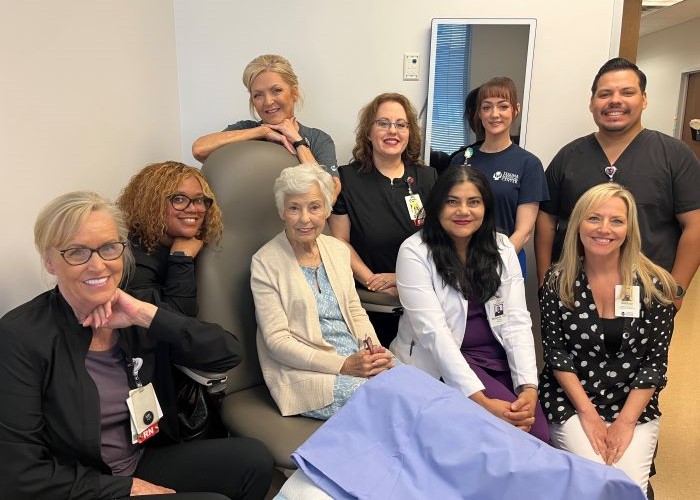Finding the Right Treatment for Optimal Recovery
July 8, 2024
 Shirley Robinson is an 80-year-old Denison local and retired office manager. She spends much of her time with her family and is an active member of her church. One day in late February, while helping two friends move a large banquet table at church, one of them lost their grip and the table fell directly onto Robinson’s knee.
Shirley Robinson is an 80-year-old Denison local and retired office manager. She spends much of her time with her family and is an active member of her church. One day in late February, while helping two friends move a large banquet table at church, one of them lost their grip and the table fell directly onto Robinson’s knee.
Robinson’s skin was torn wide open from the injury. They called an ambulance immediately, and Robinson was taken to the nearest emergency room where a surgeon sutured the wound. She considers herself lucky her leg was not broken. “My great grandchildren teased me saying it looked like a shark bite,” she recalls of the injury. “I told them they were welcome to tell people that’s what happened.”
Starting wound care treatment
Once her sutures were removed, Robinson was told she would need  to see a wound care specialist as soon as possible. Because she was considered a fall risk, she went to stay with her daughter, Sue, until her wound healed. She was also given a walker and told to stay off her injured leg as much as possible.
to see a wound care specialist as soon as possible. Because she was considered a fall risk, she went to stay with her daughter, Sue, until her wound healed. She was also given a walker and told to stay off her injured leg as much as possible.
A few days later, she went to TMC Center for Wound Healing and Hyperbaric Medicine where she began wound care treatment with the facility's Medical Director, Farah Masood, MD. “I have a lot of faith in Dr. Masood,” Robinson says. “She really knows her stuff and explained everything to make sure I understood. She was very gentle too.”
“Mrs. Robinson came in with a very complex wound,” Dr. Masood says. “There was a lot of eschar, which is dead, dry and black tissue, and blood clots beneath that. It was much more than what appeared on the surface.”
Treating wounds like a garden
Wound care starts with debridement, the removal of dead tissue so living tissue can begin to heal properly. The wound is treated with different wraps and dressings depending on its condition on a given day. If blood is beneath the tissue, a special dressing that will not stick to the wound is used. If the wound is dry, a moistening dressing is used. Once the most effective treatment is determined, the process is repeated until the wound completely heals.
“I see a wound as a garden with dead trees and flower beds,” Dr. Masood explains. “You first clean the flower beds so there is only rich, healthy soil for new plants. You apply different agents like miracle growth to determine what best promotes healthy growth of new plants. Once you discover what works, keep doing that until the plants bloom.”
Dr. Masood tried four different types of dressings on Robinson’s wound, including one from a very rare honeybee from New Zealand, and a seaweed dressing. She ultimately settled on a specialized silver dressing that seemed to promote the fastest and most effective healing. She continued to change her wrappings and apply this dressing each visit until the wound was nearly gone.
Almost completely healed
Today Robinson’s wound is the size of a dime and almost completely healed. She will be able to return to her own home once Dr. Masood says she no longer needs to come in for checkups. Robinson says her recovery would not have been possible without the tremendous help of her family support system.
“My son, Jason, installed a walk-in shower in my bathroom while I was staying with my daughter, and I’ve made a real connection with my 14-year-old granddaughter while we shared a room.” she says. “It’s been so much fun watching her be a teen and getting to know her better.”
Looking back on her three-month recovery, Robinson is amazed by her progress. “My daughter has been keeping a pictorial record of the wound,” she says. “Every time a bandage was taken off, she took a picture to show me how I’m improving. It kept me going.”
Regarding the care she received, Robinson says, “I’ve been treated really well. I wish there were more doctors out there like Dr. Masood. She knew exactly what to do. I think she’s just wonderful, and we’re lucky to have her.”
